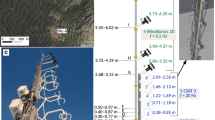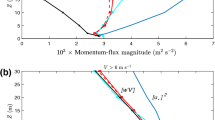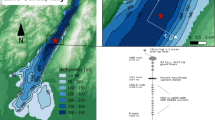Abstract
The surface temperature field induced by a turbulent buoyant jet, discharging upwards into shallow water and impinging on the water surface, is examined for the case of a power-plant cooling-water outfall off the southern California coast. The data, acquired using an airborne infrared camera, capture the evolution of turbulent-scale structure, as well as the advection of larger-scale patterns that can be used to infer the surface velocity. Some limited in-water measurements were also made. When the ambient, or receiving, water is relatively stagnant, the buoyant fluid moves nearly symmetrically outward from the impingement zone, and both the thermal and velocity fields decay over a radial distance of several tens of meters. Flow in this symmetric case appears to remain supercritical into the far-field, which differs from a recent numerical modeling study that predicts a near-field hydraulic jump. Within the plume, the data show an expanding set of thermal bands, similar to ring-like structures found in laboratory studies of a buoyant vertical jet having a stable near-field. In the presence of an alongshore current, both the plume and thermal bands become stretched out in the downstream direction; but this effect can be accounted for, and the thermal structure made symmetrical, by using an approximate two-dimensional model of the flow field. Characteristics of the observed thermal bands are compared against three ring-creation mechanisms proposed in the literature (jet vortex instability, horizontal shear instability, and internal bore formation), but the present dataset is insufficient to discriminate amongst them.















Similar content being viewed by others
References
Alavian V, Hoopes JA (1982) Thermal fronts in heated water discharges. J Hydraul Div 108:707–725
Cataldo JC (1984) Dynamic behavior of thermal plume. J Hydraul Eng 110:18–36
Chen JC (1980) Studies on gravitational spreading currents. Dissertation, California Institute of Technology, Pasadena, CA, 470 pp
Davies PA, Mofor LA (1993) Remote sensing observations and analyses of cooling water discharges from a coastal power station. Int J Remote Sens 14:253–273
Davies PA, Mofor LA, Jiao Y (1993) Foam lines generated by a spreading buoyant plume. Int J Remote Sens 14:2647–2663
Davies PA, Mofor LA, Neves MJV (1997) Comparisons of remotely sensed observations with modelling predictions for the behaviour of wastewater plumes from coastal discharges. Int J Remote Sens 18:1987–2019
Fairall CW et al (2003) Bulk parameterization of air-sea fluxes: updates and verification for the COARE algorithm. J Clim 16:571–591
Fox RW, McDonald AT (1992) Introduction to fluid mechanics. Wiley, New York
Garvine RW (1984) Radial spreading of buoyant, surface plumes in coastal waters. J Geophys Res 89:1989–1996. doi:10.1029/JC089iC02p01989
Gosink JP (1982) Thermal front formation from buoyant surface jets. J Hydraul Div 108:252–257
Green T, Roffler S (1981) Field observations of fronts and high-frequency temperature fluctuations in a thermal plume. Adv Water Resour 4:137–145. doi:10.1016/0309-1708(81)90045-2
Kuang CP, Lee JHW (2006) Stability and mixing of a vertical axisymmetric buoyant jet in shallow water. Environ Fluid Mech 6:153–180. doi:10.1007/s10652-006-0001
Kuhlman JM, Prahl JM (1975) Observations of the Kelvin–Helmholtz instability in laboratory models and field examples of thermal plumes. J Great Lakes Res 1:101–115
Lawrence GA, Maclatchy MR (2001) Radially spreading buoyant flows. J Hydraul Res 39:583–590. doi:10.1080/00221686.2001.9628287
Lee JHW, Jirka GH (1981) Vertical round buoyant jet in shallow water. J Hydraul Div Proc ASCE 107:1651–1675
Lee JHW, Chu VH (2003) Turbulent jets and plumes: a Lagrangian approach. Kluwer, Alphen aan den Rijn, p 390
Roberts PJ, Salas HJ, Reiff FM, Libhaber M (2010) Marine wastewater outfalls and treatment systems. Int Water Assn., London, p 528
Scarpace FL, Green T (1973) Dynamic surface temperature structure of thermal plumes. Water Resour Res 9:138–153
Thorpe SA, Kavcic I (2008) The circular internal hydraulic jump. J Fluid Mech 610:99–129. doi:10.1017/S0022112008002553
Tian X, Roberts PJW, Daviero GJ (2004) Marine wastewater discharges from multiport diffusers. I: unstratified stationary water. J Hydraul Eng 130:1137–1146. doi:10.1061/(ASCE)0733-9429(2004)
Trent DS, Welty JR (1973) Numerical thermal plume model for vertical outfalls in shallow water. EPA, Tech Ser. Rep. EPA-R2-73-162, 486 p. Available from National Service Center for Environmental Publications (NSCEP), nepis.epa.gov/Adobe/PDF/910082UB.PDF
Turner JS (1973) Buoyancy effects in fluids. Cambridge University Press, Cambridge
Uddin N, Neumann SO, Weigand B (2013) LES simulations of an impinging jet: on the origin of the second peak in the Nusselt number distribution. Int J Heat Mass Transf 57:356–368
Ulasir M, Wright SJ (2003) Influence of downstream control and limited depth on flow hydrodynamics of impinging buoyant jets. Environ Fluid Mech 3:85–107. doi:10.1023/A:1022027003377
Violato D, Ianiro A, Gennaro G, Scarano F (2012) Three-dimensional vortex dynamics and convective heat transfer in circular and chevron impinging jets. Int J Heat Fluid Flow 37:22–36. doi:10.1016/j.ijheatfluidflow.2012.06.003
Wright SJ, Roberts PJW, Zhongmin Y, Bradley NE (1991) Surface dilution of round submerged buoyant jets. J Hydraul Res 29:67–89. doi:10.1080/00221689109498993
Acknowledgments
This work was made possible through the support of the Office of Naval Research and conducted under Naval Research Laboratory project 72-9201. NRL contribution NRL/JA/7230–14-0041.
Author information
Authors and Affiliations
Corresponding author
Appendix: Potential flow
Appendix: Potential flow
For a two-dimensional flow that is both incompressible and irrotational, velocity components \(u\) and \(v\) can be expressed in terms of a stream function, \(\varPsi \), and a velocity potential, \(\phi \):
For a uniform flow with velocity components \(u=U\) and \(v\) = 0, the stream function and velocity potential can be written as
In case of a point source, velocities are given in polar coordinates with radial velocity \(V_{r}=q/(2\pi r)\), where \(q\) is volume flow rate per unit depth at the point source, and tangential velocity \(V_{\theta } = 0\). The resulting stream function and velocity potential are given as
As the flow is incompressible and irrotational, both \(\varPsi \) and \(\phi \) satisfy Laplace’s equation. Therefore, solutions for multiple flow patterns can be linearly superposed. Thus the solution for a source in an ambient flow becomes
Rights and permissions
About this article
Cite this article
Marmorino, G., Savelyev, I. & Smith, G.B. Surface thermal structure in a shallow-water, vertical discharge from a coastal power plant. Environ Fluid Mech 15, 207–229 (2015). https://doi.org/10.1007/s10652-014-9373-0
Received:
Accepted:
Published:
Issue Date:
DOI: https://doi.org/10.1007/s10652-014-9373-0




